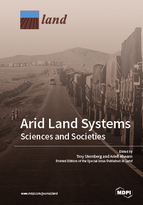Arid Land Systems: Sciences and Societies
A special issue of Land (ISSN 2073-445X).
Deadline for manuscript submissions: closed (15 March 2018) | Viewed by 167355
Special Issue Editors
Interests: extreme climate hazards; water, steppe vegetation; desertification; social–environmental interaction
Special Issues, Collections and Topics in MDPI journals
Special Issue Information
Dear Colleagues,
Understanding deserts and drylands is essential as arid landscapes cover >40% of the Earth and are home to two billion people. Today's problematic environment–human interaction needs contemporary knowledge to address dryland complexity. Physical dimensions in arid zones—land systems, climate and hazards, ecology—are linked with social processes that directly impact drylands, such as land management, livelihoods, and development. Challenges require integrated research that identifies systemic drivers across global arid regions. Measurement and monitoring, field investigation, remote sensing, and data analysis are effective tools to investigate natural dynamics. Equally, inquiry into how policy and practice affect landscape sustainability is key to mitigating detrimental activity in deserts. Exploring relations between socio-economic forces and degradation, agro-pastoral rangeland use, drought and disaster and resource extraction reflect land interactions. Contemporary themes of food security, conflict and conservation are interlinked in arid environments.
This Special Issue unifies desert science, arid environments, and dryland development. We seek papers that identify land dynamics, address system risks and delineate human functions through original research in arid zones. Mixed methodologies that reflect the vital links between social and environmental science in global deserts is welcome. Work that engages with today's topical themes and presents novel analyses is particularly encouraged.
Dr. Troy Sternberg
Dr. Ariell Ahearn
Guest Editors
Manuscript Submission Information
Manuscripts should be submitted online at www.mdpi.com by registering and logging in to this website. Once you are registered, click here to go to the submission form. Manuscripts can be submitted until the deadline. All submissions that pass pre-check are peer-reviewed. Accepted papers will be published continuously in the journal (as soon as accepted) and will be listed together on the special issue website. Research articles, review articles as well as short communications are invited. For planned papers, a title and short abstract (about 100 words) can be sent to the Editorial Office for announcement on this website.
Submitted manuscripts should not have been published previously, nor be under consideration for publication elsewhere (except conference proceedings papers). All manuscripts are thoroughly refereed through a single-blind peer-review process. A guide for authors and other relevant information for submission of manuscripts is available on the Instructions for Authors page. Land is an international peer-reviewed open access monthly journal published by MDPI.
Please visit the Instructions for Authors page before submitting a manuscript. The Article Processing Charge (APC) for publication in this open access journal is 2600 CHF (Swiss Francs). Submitted papers should be well formatted and use good English. Authors may use MDPI's English editing service prior to publication or during author revisions.







